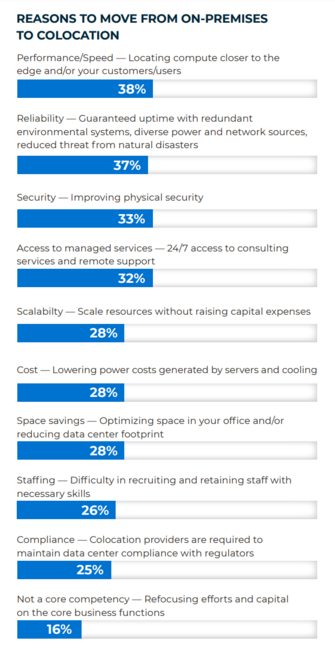
9 Reasons for Moving On-Premises Workloads to Colocation
We recently released the 2022 State of the Data Center Report, which was developed in conjunction with CIO. As you would expect, the report covers a lot of topics, including the fact that colocation has become the hub for hybrid cloud.

One of the findings I think you will find interesting is that more of those resources and workloads are being migrated from on-premises data centers to colocation to gain better access to cloud providers to interoperate workloads.
IT leaders are becoming “cloud smart,” which means they understand quite well the advantages of moving a resource where it will best meet their business goals. Traditionally, the primary justification for on-premises deployment is control. But colocation provides equal or better control, at a lower cost, and offers other value-adds. Let’s look at the research into why enterprises, including financial services firms, choose colocation.
Why Move Workloads from On-Premises Data Centers to Colocation
The 2022 State of the Data Center report asked respondents to rank the reasons for moving from on-premises to colocation.1 Figure 1 shows nine reasons, led by performance/speed, reliability and security. Although, as you can see, all nine are priorities that enterprises wrestle with every day.
Digging Deep Into the Reasons to Choose Colocation
The brief descriptions in Figure 1 provide the core idea behind each reason, but I’d like to expand on a few.
Performance/Speed
Location and proximity to users and customers are important because they factor into latency. The location of your on-premises data center can be a performance obstacle, especially when you have a distributed workforce and customers are far-flung. CoreSite solves for this by offering data centers located across the U.S., where users and highly populated markets are.
Interconnection capabilities are another dimension of performance. Think of interconnection as a way for connected organizations to exchange data – leveraging a “digital supply chain” linking other enterprises, IT service providers, managed services providers, public cloud service providers, and other entities in a digital ecosystem. “On-demand” interconnection translates into fast data exchange and responsive customer service. Another layer of interconnection is inter-market connectivity, which allows you to connect securely and with low latency to data centers in other geographic regions. This capability plays into strategies for business expansion, data access and data sovereignty.
And, let’s not overlook the aspect of performance enabled by a colocation facility’s technical support people – remote hands – who are available to be your onsite staff when your techs can’t be present. In fact, many enterprises hire remote hands for things like cabling, wiring, racking and stacking equipment, device management, media management, and even circuit migrations coordinated with carriers and ISPs. With reliable onsite tech support, your staff can focus on other performance-related priorities.
Reliability
Most businesses today can’t afford even minimal downtime. And, it is well-known that downtime is no friend of revenue or reputation. As the description in Figure 1 states, colocation providers typically guarantee uptime based on data center redundancy, which can vary from one facility to another. Dig into the redundant systems, including business continuity and disaster recovery, and compare them to your on-premises setup. Chances are good that colocation is the stronger option.
Direct connection to cloud providers is another factor in reliability. Direct connection is usually discussed as a way to cut data egress fees. However, direct cloud connection between a private network and public cloud is more reliable as well.
Security
The physical security of a colocation facility must be top-notch. This means layers of security. To name a few: perimeter fencing and exterior cameras, screening for everyone entering the facility, dual authentication for computer room access, controlled access to cages and racks via card readers and biometric scanners, and interior video cameras.
Data security usually comes up in connection with compliance. As Figure 1 states, colocation providers are required to maintain compliance within their data centers, although certifications may vary among providers. However, the point is that your organization doesn’t have to invest in compliance-related physical security much less take on the burden of staffing and keeping it up to date.
Access to Managed Services
This reason is in the top half of the list of nine in part due to managed services’ role in digital transformation strategies. A Forbes article describes three ways to leverage digital ecosystems, and one is to accelerate digital transformation.2 The article emphasizes the importance of digital readiness and states, “…it’s no secret that digital ecosystems could become one of the prominent business models for companies around the globe.”
In fact, 33% of respondents in the 2022 State of the Data Center report cite access to managed services as a top-tier colocation attribute, compared to 16% in the 2021 report. Since 2020, the availability of managed services has become the No. 1 attribute sought in colocation provider evaluations.1 Here’s the context. Organizations don’t expect colocation providers to deliver managed services – the emphasis is on access to managed services providers. This means access to an ecosystem that offers many types of interconnection resources and services such as managed network, cybersecurity, compute and storage. An ecosystem becomes part of your IT architecture. Check out the number and breadth of managed services providers in the colocation providers’ ecosystems.
Even Financial Services Firms Are Choosing Colocation
Financial services firms are among the most conservative businesses when it comes to IT and infrastructure strategy, but some are choosing colocation for certain use cases. One financial services respondent in the 2022 State of the Data Center report says that AI and ML at the edge, “necessitates colocation,” as well as federated learning as a driver for AI workloads in colocation. Another respondent points out the benefits of colocation include “more options, more flexibility.” The fact that financial services executives are expressing confidence in colocation is a big thumbs up for hybrid IT and colocation.
Colocation Is a Foundational Component of Hybrid IT
Firms across industries are making edge and hybrid IT moves. As more IT leaders realize the value of a hybrid IT approach, they are rethinking the mix of clouds, on-premises and colocation. A few value-adds of colocation not covered in Figure 1 include interoperability – an area in which colocation shines – as well as OpEx savings, energy efficiency and simplified multicloud and network management.
You’ll find a lot more insights in the 2022 State of the Data Center Report that can help you be more cloud-smart. Please download and share it with colleagues.
And when you are ready to experience a state-of-the-art colocation facility in person, book a CoreSite data center tour. We would welcome the opportunity to show you around!










